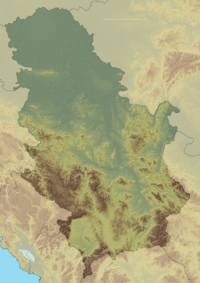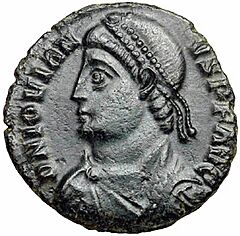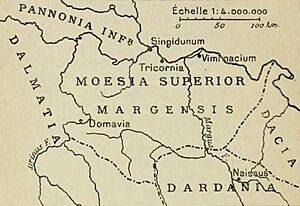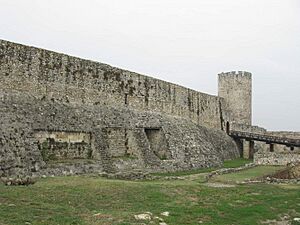Singidunum facts for kids
Quick facts for kids Singidunum |
|
|---|---|
| Belgrade Serbia |
|
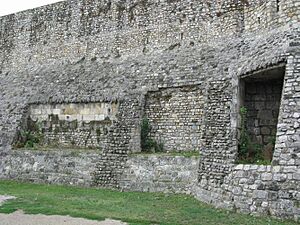
Probing of the medieval walls of the Belgrade Fortress, where the walls of the Roman castrum Singidunum were discovered.
|
|
| Coordinates | 44°49′N 20°28′E / 44.82°N 20.46°E |
| Type | Fortification, mixed |
| Site information | |
| Open to the public |
Yes |
| Site history | |
| Built | 1st century |
| Materials | Stone |
Singidunum was an ancient city that grew into what we now call Belgrade, the capital of Serbia. Its name comes from the Celts, a group of people who settled here in the 3rd century BC. They were called the Scordisci tribe.
Later, the Roman Republic took over the area around 75 BC. Singidunum became an important fort on the Danubian Limes, which was the Roman border along the Danube River. A Roman army group, the Legio IV Flavia Felix, was stationed there from 86 AD.
Singidunum was also the birthplace of the Roman Emperor Jovian. Sadly, the city was attacked and destroyed by groups like the Huns in 441 AD and the Avars and Slavs in 584 AD. By the early 7th century, the fort of Singidunum was completely ruined.
Today, a big part of downtown Belgrade is an "Archaeological Site of Singidunum." It became a protected area on June 30, 1964, meaning its ancient history is preserved.
Contents
Celtic History
How Singidunum Began
Long ago, in the 7th and 6th centuries BC, tribes like the Scythians and Thracians traveled through this area. Then, in the 4th and 3rd centuries BC, Celtic groups arrived. One Celtic tribe, the Scordisci, settled on a strategic hill where the Danube and Sava rivers meet. This is where modern Belgrade is today.
The Scordisci are believed to have built Singidunum. It was first mentioned in 279 BC as a fortified settlement, meaning it already had defenses. We don't have many remains of the Celtic town itself. Most evidence comes from burial sites found in areas like Karaburma and Rospi Ćuprija. These sites contained valuable items belonging to Scordiscan warriors. Celtic culture also influenced the people of Singidunum, mixing later with Roman traditions.
The Celtic fort was simple, built on the Terazije ridge, overlooking the river meeting point. This is where the Belgrade Fortress stands now. Celts also lived in smaller, open settlements called opidums around the main fort. Some historians think the Celtic fort might have been closer to the burial sites. These Celtic settlements were part of the La Tène culture.
Traces of the Scordisci have also been found in other Belgrade neighborhoods like Autokomanda, Bežanija, Ada Ciganlija, and Ada Huja. Zemun, now part of Belgrade, was also founded by the Scordisci around the same time as Singidunum.
What the Name Means
The name "Singidunum" has Celtic roots. The second part, dunum, means "enclosure" or "fortress." For the first part, singi-, there are a few ideas. One theory is that it's a Celtic word for "circle," making it "round fort." Another idea is that it comes from the Sings, a Thracian tribe who lived in the area before the Celts arrived.
The ancient writer Herodotus mentioned tribes like the Sighnis and Sinds living here in the 5th century BC. Over time, their names might have changed and led to the name Singidunum. The Sinds were a Scythian tribe who moved to this region in the 6th century BC. Recent discoveries suggest the Sinds lived here in the 5th and 4th centuries BC.
Roman Times
The Romans started conquering lands around Singidun in the 1st century BC. In 75 BC, a Roman leader named Gaius "Quintus" Scribonius Curio invaded the Balkans up to the Danube River. He wanted to drive out the local tribes. The Romans won battles but didn't stay long.
It wasn't until the rule of Octavian that the region became stable. In 29 BC, Marcus Licinius Crassus led a campaign that secured the area. The region officially became the Roman province of Moesia before 6 AD. Singidun was then Romanized to Singidunum.
Singidunum became an important settlement in Moesia. It was located between two other significant Roman cities, Sirmium and Viminacium. It was also just across the Sava River from Taurunum. Singidunum was a key point on the Via Militaris, an important Roman road. This road connected forts and settlements along the Danube border, known as the limes or border. This section was called Limes Moesiae.
The first Roman soldiers in Singidunum were likely from the Legio VIII Augusta between 46 AD and 69 AD. Singidunum truly grew when the Legio IV Flavia Felix arrived in 86 AD. This legion stayed there for most of the time until the mid-5th century.
Because of the legion, a square-shaped castrum (fort) was built. This fort is located where the Upper Town of today's Belgrade Fortress is. Construction began around 100 AD. At first, the fort had earth walls and wooden fences. But soon, it was rebuilt with stone, becoming the first stone fort in Belgrade's history. You can still see some remains near the northeast corner of the fortress.
The legion also built a floating bridge over the Sava River, connecting Singidunum with Taurunum. This made Singidunum a major crossroads, linking the Via Militaris with the western parts of the Roman Empire. The 6,000 soldiers of the legion were crucial for defending against the Dacians, who lived across the Danube. To strengthen the city, Romans also settled their retired soldiers near the fort. Over time, a large town grew around the castrum. The main street of this town followed the path of modern Knez Mihailova Street.
In 169 AD, Emperor Hadrian gave Singidunum the rights of a municipium. This meant it had its own local government, rules, and laws. By 239 AD, Singidunum became a full-fledged Roman colony.
The Roman Emperor Jovian, who made Christianity the official religion of the Roman Empire again, was born in Singidunum in 332 AD. He is often called the "only Roman emperor born in Belgrade."
Singidunum and the province of Moesia had a peaceful time for a while. But this didn't last. The Roman Empire began to face problems from outside and within. The province of Dacia started to fall apart under attacks from the Goths in 256 AD. By 270 AD, Emperor Aurelian had to abandon Dacia. Singidunum found itself back on the edge of the weakening Empire, one of the last strongholds against invading tribes.
Even though it was less important than Sirmium, Singidunum remained a key military outpost in the 4th century. It also became a center for bishops and a major site for a Christian group called Arianism.
In 378 AD, Singidunum was heavily damaged by the invading Goths. The city was only partly rebuilt. In 395 AD, after the death of Emperor Theodosius I, the Roman Empire split into two. Singidunum ended up on the northwestern border of the Eastern Roman Empire, also known as the Byzantine Empire.
City Layout
Singidunum was a well-planned city. It had a forum (a public square), temples, organized and paved streets, an aqueduct for water, and a sewage system. The city was built in a grid pattern, with streets meeting at right angles. You can still see this grid in modern Belgrade with streets like Uzun Mirkova and Kralja Petra I.
Studentski Trg (Students' Square) was once the Roman forum. It was surrounded by thermae (public baths), whose remains were found in the 1970s. Other Roman artifacts like tombs, sculptures, and coins have been found in areas around Belgrade.
Singidunum covered parts of five modern Belgrade municipalities. The castrum (fort) was in today's Belgrade Fortress. The civilian area stretched from Kralja Petra Street, along the Sava and Danube slopes, to Kosančićev Venac. Roman burial grounds (necropolises) extended from Republic Square along Bulevar kralja Aleksandra all the way to Mali Mokri Lug. The necropolis at Republic Square had well-preserved graves from the 1st century AD.
The main civilian settlement was between modern Simina and Brankova streets and Republic Square. The rectangular castrum itself covered the Upper Town of the Fortress and Kalemegdan Park. It had tall walls made of white Tašmajdan limestone and covered about 16 to 20 hectares.
Below the castrum, near the rivers, was a suburb called the Lower Town. It was protected by walls and towers. South of the fort was another civilian Roman town. Next to the Lower Town, on the Danube's right bank, was a port that was used until the 18th century.
Modern Bulevar Kralja Aleksandra was the start of the 924 km long Via Militaris. This road connected Singidunum to Constantinople and other forts along the Danube border, like Viminacium. Built in the 1st century AD, the road was 6 meters wide and had shops, workshops, and armories. Romans were buried along the road in stone sarcophagi. You can still see parts of the Roman road under the "Depo" area.
The Romans got stone from a quarry in the modern neighborhood of Tašmajdan. They used it for building Singidunum and for many sarcophagi. An aqueduct brought water from the modern Kumodraž area. It joined another aqueduct from Mokri Lug and continued to the castrum. Both Mokri Lug and Kumodraž are hills, so water flowed naturally downhill to Singidunum. The area of Cvetkova Pijaca had three more Roman water systems. Aqueducts passed through modern Belgrade's center, Terazije, and the main pedestrian zone, Knez Mihailova Street. This street still follows the original Roman street plan.
In the area between Karaburma, Rospi Ćuprija, and the former island of Ada Huja, Romans grew grapevines and used thermal springs for public bathhouses.
Nearby Settlements
The main town and fort near Singidunum was Taurunum, which is modern Zemun. It was across the Sava River. This Celtic settlement became a Roman town in the 1st century AD and later served as a harbor for Singidunum's fleet.
Remains from the Singidunum period have been found in the village of Brestovik to the east. There's a Roman tomb in Brestovik from around 300 AD, discovered in 1895. It likely belonged to a wealthy local. A well-preserved bust of Emperor Macrinus (who ruled 217–218 AD) was found in the village of Boleč, near the ancient Tricornium.
Tricornium, meaning "three-horned fortification," is modern Ritopek. It had an important military camp called Castra Tricornia. The name came from three hills in the area. A ceremonial breastplate from 258 AD, belonging to a soldier of Legio VII Claudia, was found there. Many other Roman artifacts, like silver coins, have also been discovered.
Tricornium was one of the forts built to protect the Via Militaris. Other forts included Mutatio ad Sextum Militare (modern Grocka) and Mutatio ad Sextum (Mali Mokri Lug).
The top of Avala mountain was also used by the Romans. They built a fortified outpost there, probably on an older Celtic site. This outpost guarded the roads to Singidunum and protected the many mines on the mountain. Romans extracted lead, zinc, silver, and mercury near modern Ripanj. This outpost was the base for the later medieval fortress of Žrnov.
The nearby Kosmaj mountain was also rich in ores. In July 2000, during excavations in the village of Babe, a hidden entry to a large Roman mine complex was found. There is evidence of silver, iron, and lead extraction. In the 3rd century AD, the Kosmaj mines were very important to the Roman Empire. They were managed by a Roman official named Babenius, whose name is kept in the village name Babe. Experts have found many mining burial sites around Babe, Stojnik, and Guberevac. It's thought there are about 100 ancient mining shafts on Kosmaj, going 2 km underground and spreading 25 km wide.
In 1963, a tractor plowing land in Zemun Polje started unearthing old coins, a sculpture head, pottery, and other objects. Archaeologists found it was a Roman fort on the old Sirmium-Singidunum road. This previously unknown settlement was square-shaped, with sides 3 km long. At the time, it was the largest "outer suburb" of Singidunum known.
Byzantine Rule and Migrations
In the 5th and 6th centuries, the region of Moesia faced many destructive attacks. Groups like the Huns, Ostrogoths, Gepids, Sarmatians, Avars, Slavs, and Herules invaded. Singidunum fell to the Huns in 441 AD. They destroyed the city and its fort, selling its Roman people into slavery.
Over the next two hundred years, the city changed hands many times. The Romans took it back after the Huns left in 454 AD, but the Sarmatians soon conquered it. In 470 AD, the Ostrogoths took the city, pushing out the Sarmatians. The Gepids invaded in 488 AD, but the Ostrogoths recaptured it in 504 AD. Six years later, the Eastern Roman Empire (Byzantines) got the city back through a peace treaty.
The Byzantine emperor Justinian I rebuilt Singidunum completely in 535 AD. He restored the fortress and city to its former military importance. Singidunum became a crucial border stronghold. However, Justinian only rebuilt the area within the old legion's camp.
The city had a short peaceful period of about fifty years. But then, the Avars attacked in 584 AD, though the Byzantines recaptured it in 596 AD. The city was constantly attacked by the Avars and their allies, the Slavs. Singidunum was used as a base during Maurice's Balkan campaigns, but it was lost again in the early 7th century when the Avars destroyed and burned Singidunum to the ground. This destruction happened before 614 AD. Around 630 AD, the Slavs permanently settled in the area.
Belgrade's New Name
After its destruction by the Avars in the early 7th century, the ancient city of Singidunum is no longer mentioned in historical records for a few centuries. We don't know much about what happened there from the late 6th century to the second half of the 9th century.
However, the Slavs settled in the city during this time. They gave it a new name: Beograd, which means "white city." This name likely came from the white Tašmajdan limestone that the Romans used to build the fort.
The Slavic name "Belgrade" was first mentioned in a letter written on April 16, 878 AD, by Pope John VIII to the Bulgarian prince Boris I Mihail. At that time, Belgrade was part of the First Bulgarian Empire. The Slavic settlement must have existed for a while, as the new name was clearly accepted. The city was also home to a bishop, as the pope mentioned episcopatus Belogradensis ("bishop of Belgrade"). Under its new name, Belgrade would eventually become important again, especially after the Byzantines recaptured it.
Discovering Ancient Singidunum
What We've Found
Over time, the growth of modern Belgrade has covered or destroyed more than 80% of the ancient Singidunum's civilian settlement and burial grounds. Only three areas have been dug up, preserved, and then reburied: Akademski Park, Park Proleće, and Tadeuša Košćuškog Street. Only a small part of the remaining area has been explored. We know more about the northwest wall with its towers, and we can guess the layout of the streets and where soldier barracks were.
In July 2016, the city announced plans to rebuild Studentski Trg and build an underground garage. Many people and experts criticized this because the archaeological site under the park hadn't been fully explored. They worried that Roman and Byzantine remains would be permanently destroyed. This area is considered one of the most important historical zones of old Belgrade and is key to understanding ancient Singidunum.
Downtown Discoveries
When the foundations for the Monument to Prince Michael were dug in 1882, tombs from different Roman periods were found. One brick tomb and 15 grave pits were discovered. Some were "well-tombs," which are more than 10 meters deep. These are rare in the area and might have come from Gaul. The brick tomb, found near Čika Ljubina Street, contained a lamp. Other pits were where the monument stands today.
Items found in the tombs included pottery, statues, floor tiles, bronze and bone needles, bricks, and lamps. The pits were filled with ashes and animal bones. Coins and bronze rings were also found. These "well-tombs" are thought to be the oldest part of the Singidunum burial ground, from around 100 AD. The brick tomb is from around 400 AD, and some of its bricks have the stamp of the Legio IV Flavia Felix. During renovations in 2018-2019, two more damaged tombs were found.
A burial ground from the 3rd century was located in the modern neighborhoods of Zeleni Venac, Kosančićev Venac, and Varoš Kapija. Remains were found during construction in the 1930s. At 16 Brankova Street, a Roman tomb was discovered in 1931, with pottery and coins from the time of emperors Aurelian and Claudius Gothicus. The grave was made from reused parts of a stone slab. This slab had a carving of a human bust and an inscription. Other well-preserved graves were found nearby. During the time between the World Wars, a gold earring from the early Middle Ages was found in Kamenička Street. When foundations for the Medical Association building were dug, over 4 kg of 5th-century Roman coins were discovered. Some remains were also found during hotel construction in 2018.
In Dorćol, at the crossroads of Gospodar Jevremova and Kneginje Ljubice streets, a temple dedicated to the Greek goddess Hecate was discovered in 1935. As foundations for a new building were being dug, a 1.5-meter long stone beam with a Latin inscription to Hecate was found 2.5 meters deep. The inscription was made by Valerius Crescentio, a soldier of the Legio IV Flavia Felix, around 235 AD. It disappeared after its discovery but was later found and given to the National Museum in Belgrade. This is a rare finding of Hecate in Serbia. Since the surrounding area was a burial ground, the temple was likely part of it, as Hecate's temples were often built in cemeteries.
The original earth and wood fort was around Studentski Trg and Knez Mihailova Street. The oldest Roman graves, from the 1st and early 2nd centuries, were found here. In the Lower Town section of today's Fortress, remains from the 2nd and 3rd centuries were discovered. These include public baths, homes, and a shrine to Mithras. The forum, which had temples to Jupiter and Nemesis, was near the Cathedral Church, where the National Bank of Serbia building is now. Another public bath was in Čika Ljubina Street. The entire settlement was surrounded by large burial grounds. The main and largest one stretched along the Via Militaris towards Viminacium, which is today's Bulevar Kralja Aleksandra. Many graves, grave markers, and altars were found there.
The northern part of the Academy Park, on Studentski Trg, was excavated in 1968 when a fuel tank was being built. Under the grass, remains of ancient Roman public baths were found. These included the frigidarium (cold water room), laconicum (warm water room), and caldarium (hot water pools). The site became an archaeological dig in 1969, and 8 rooms were found, including parts of the brick furnace that heated the water. It was a public bath for everyone, from the 3rd or 4th century. The remains were visible until 1978, but because there wasn't enough money to continue digging or cover them, they were preserved and buried again. Remains of another public bath on the nearby Faculty of Philosophy Plateau are still visible and used as benches.
In 2004, digging for a shopping mall in Rajićeva Street, next to Knez Mihailova, uncovered remains from ancient and late ancient times. Parts of the southwest wall and a double trench were found. The trench from the 3rd century was filled with coins, lamps, pottery, and jars. Nearby, at the corner of Knez Mihailova and Kralja Petra, a cobblestone area from the 2nd century was found. This was a public space right before the entrance to the fortress.
Almost every construction project downtown that involves digging finds more remains. In 2007, at the corner of Bulevar Kralja Aleksandra and Kneza Miloša street, several burial grounds were found. Across the street, in Pioneers Park, 19 tombs were discovered when an underground garage was dug. In 2008, in Čika Ljubina Street, remains of a 4th-century house were found, including part of the floor and a doorstep. Some walls were decorated with frescoes. Similar findings have been made in Kosančićev Venac and Tadeuša Košćuškog streets. Also in 2008, late ancient remains were found at the corner of Takovska and Kosovska streets, including Roman tombs. Parts of the Roman castrum from the 2nd century were found under Tadeuša Košćuškog during reconstruction in June 2009; they were preserved and reburied. In Cincar Jankova Street, five graves from the late 1st century and three canals were discovered.
Discoveries in Outer Neighborhoods
Artifacts from before the Roman period, from the Late Iron Age, have been found in modern neighborhoods and suburbs like Karaburma, Zemun, Batajnica, and Ritopek. A Scythian-style pendant from the 5th century BC, shaped like a stylized griffin's head, was discovered in Ritopek.
Remains were also found near Karaburma and Rospi Ćuprija, including a necropolis (burial ground) with many valuable artifacts.
See also
- Archaeological Site Pionirski Park


